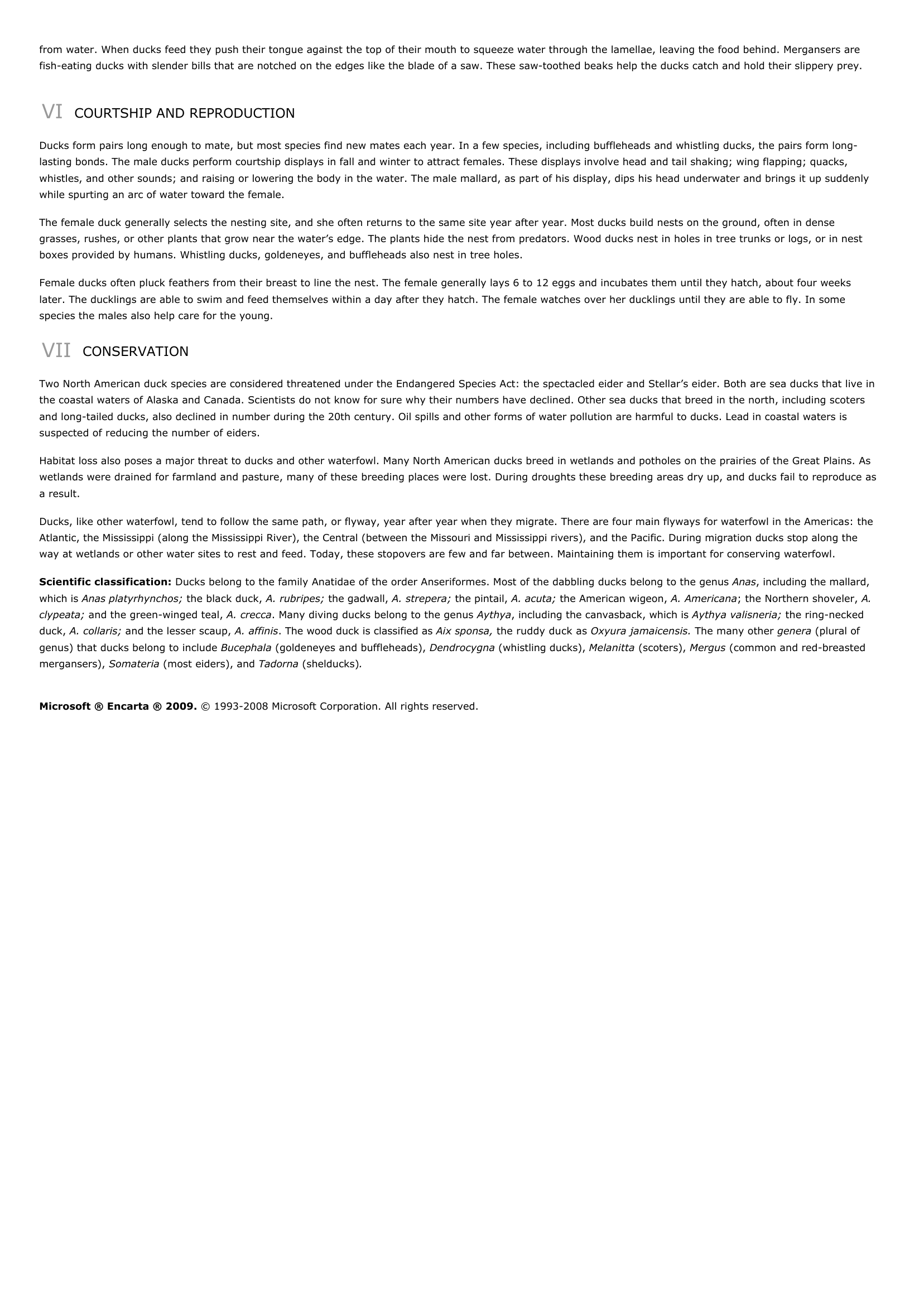Duck - biology.
Publié le 11/05/2013
Extrait du document
«
from water.
When ducks feed they push their tongue against the top of their mouth to squeeze water through the lamellae, leaving the food behind.
Mergansers arefish-eating ducks with slender bills that are notched on the edges like the blade of a saw.
These saw-toothed beaks help the ducks catch and hold their slippery prey.
VI COURTSHIP AND REPRODUCTION
Ducks form pairs long enough to mate, but most species find new mates each year.
In a few species, including buffleheads and whistling ducks, the pairs form long-lasting bonds.
The male ducks perform courtship displays in fall and winter to attract females.
These displays involve head and tail shaking; wing flapping; quacks,whistles, and other sounds; and raising or lowering the body in the water.
The male mallard, as part of his display, dips his head underwater and brings it up suddenlywhile spurting an arc of water toward the female.
The female duck generally selects the nesting site, and she often returns to the same site year after year.
Most ducks build nests on the ground, often in densegrasses, rushes, or other plants that grow near the water’s edge.
The plants hide the nest from predators.
Wood ducks nest in holes in tree trunks or logs, or in nestboxes provided by humans.
Whistling ducks, goldeneyes, and buffleheads also nest in tree holes.
Female ducks often pluck feathers from their breast to line the nest.
The female generally lays 6 to 12 eggs and incubates them until they hatch, about four weekslater.
The ducklings are able to swim and feed themselves within a day after they hatch.
The female watches over her ducklings until they are able to fly.
In somespecies the males also help care for the young.
VII CONSERVATION
Two North American duck species are considered threatened under the Endangered Species Act: the spectacled eider and Stellar’s eider.
Both are sea ducks that live inthe coastal waters of Alaska and Canada.
Scientists do not know for sure why their numbers have declined.
Other sea ducks that breed in the north, including scotersand long-tailed ducks, also declined in number during the 20th century.
Oil spills and other forms of water pollution are harmful to ducks.
Lead in coastal waters issuspected of reducing the number of eiders.
Habitat loss also poses a major threat to ducks and other waterfowl.
Many North American ducks breed in wetlands and potholes on the prairies of the Great Plains.
Aswetlands were drained for farmland and pasture, many of these breeding places were lost.
During droughts these breeding areas dry up, and ducks fail to reproduce asa result.
Ducks, like other waterfowl, tend to follow the same path, or flyway, year after year when they migrate.
There are four main flyways for waterfowl in the Americas: theAtlantic, the Mississippi (along the Mississippi River), the Central (between the Missouri and Mississippi rivers), and the Pacific.
During migration ducks stop along theway at wetlands or other water sites to rest and feed.
Today, these stopovers are few and far between.
Maintaining them is important for conserving waterfowl.
Scientific classification: Ducks belong to the family Anatidae of the order Anseriformes.
Most of the dabbling ducks belong to the genus Anas , including the mallard, which is Anas platyrhynchos; the black duck, A.
rubripes; the gadwall, A.
strepera; the pintail, A.
acuta; the American wigeon, A.
Americana ; the Northern shoveler, A. clypeata; and the green-winged teal, A.
crecca .
Many diving ducks belong to the genus Aythya , including the canvasback, which is Aythya valisneria; the ring-necked duck, A.
collaris; and the lesser scaup, A.
affinis .
The wood duck is classified as Aix sponsa, the ruddy duck as Oxyura jamaicensis. The many other genera (plural of genus) that ducks belong to include Bucephala (goldeneyes and buffleheads), Dendrocygna (whistling ducks), Melanitta (scoters), Mergus (common and red-breasted mergansers), Somateria (most eiders), and Tadorna (shelducks) .
Microsoft ® Encarta ® 2009. © 1993-2008 Microsoft Corporation.
All rights reserved..
»
↓↓↓ APERÇU DU DOCUMENT ↓↓↓
Liens utiles
- Alligator - biology.
- Amphibian (animal) - biology.
- Basilisk - biology.
- Boa - biology.
- Caecilian - biology.

































